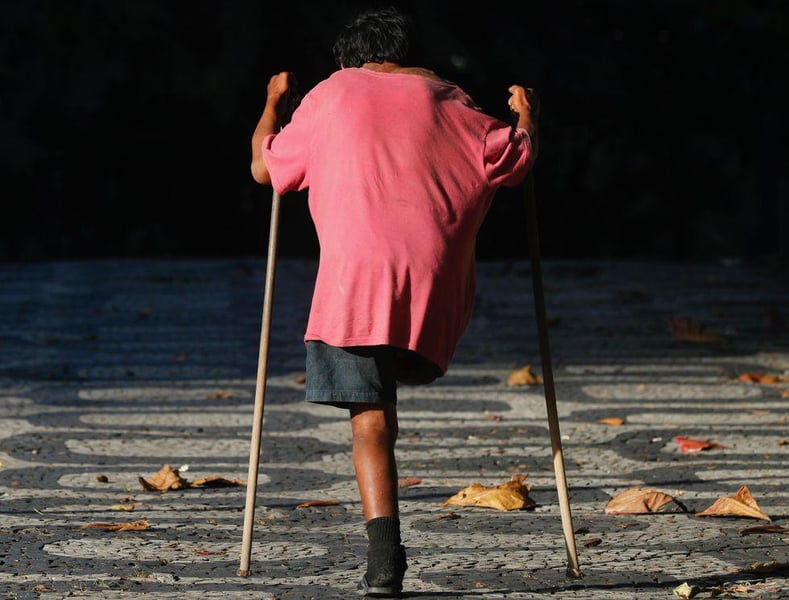Get Healthy!

- Cara Murez
- Posted August 18, 2021
Diabetes-Linked Amputations: Your Race, State Matters
Poorly controlled diabetes can lead to amputations of toes, feet or legs, though it isn't inevitable.
But your race and where you live might play a big part in whether amputation is your fate if you are diagnosed with the blood sugar disorder, new research suggests.
"If you go to the experts that are there to help you live a [healthy] lifestyle with diabetes, this does not have to happen to you," said Dr. David Alper, a member of the American Diabetes Association's (ADA) Northeast Leadership Board and trustee of the American Podiatric Medical Association.
Researchers reported recently in the ADA journal Diabetes Care that minor lower extremity amputations rose among American adults with diabetes between 2009 and 2017, while major amputations held steady.
Major amputations rose for whites, Midwesterners and those in rural areas, the study found. Black people were less likely to have a minor amputation, but more likely to have a major amputation than white people.
The increase in minor amputations was most pronounced among Asian Americans and Pacific Islanders, as well as those who were Native American, rural residents and those living in the West.
Major amputations are those above the foot, or below or above the knee. Amputations of the foot or toe are considered minor. Poor diabetes control can lead to serious health issues, including neuropathy, which is reduced feeling in the extremities, and potentially to amputation.
"The good news is the major-to-minor amputation ratio is dropping, which means there are fewer major amputations being conducted and more minor amputations," said study author Marvellous Akinlotan, a research assistant professor at Texas A&M University College of Nursing in Bryan, Texas. "Even though an amputation of any kind can be devastating, that ratio is dropping and that shows that diabetes management efforts are paying off."
She said that includes "the comprehensive foot examinations that are now part of the diabetes management programs" and earlier detection of infections.
Patients in the South were more likely to have a major amputation than those living in the Northeast or urban areas, the study found.
The increased odds for amputation for people in rural areas is consistent with other studies that have reported poorer health outcomes for residents of rural areas. Researchers said this could be due to less access to specialized diabetes-related medical care, fewer health care providers, lower rates of health insurance coverage, lower income and limited public transit.
"If an individual doesn't have health insurance, they're less likely to get a regular check, and if the blood sugar is already out of control, the individual may not be aware or able to get care in a timely manner," Akinlotan said.
She said potential solutions include comprehensive ongoing care of patients with diabetes and a better understanding of the cultural factors that are at play, particularly among ethnic groups and Southerners.
The study suggested these findings could help policymakers and health care providers offer more targeted interventions, including telehealth and web-based diabetes care and education.
The results are not surprising, said Alper, who was not involved in the study. Diabetes experts have been aware of the increases in certain types of amputation and that they're happening in an uneven way, depending on race, economic situation and location, he said.
The problem also has escalated during the COVID-19 pandemic as some people have been afraid to go to doctor appointments.
Individuals who have a family history of uncontrolled diabetes or diabetes-related amputation are more likely to experience that themselves. Alper said the reality is that health care is less available in poorer, more rural areas, which means patients are not getting early intervention or good quality diabetes control. The wide availability of sugary drinks and the high cost of a diabetes-controlling diet add to the challenges, he said.
A key to changing this situation is education, Alper said, and not just through medical professionals in a doctor's office but through a nurse educator standing up in church, for example, and talking about diabetes. Employers can also offer education, he added.
"The truth is, especially in 2021, people are getting their medical education from ancillary providers, from nurse practitioners, physician's assistants and diabetic nurse educators," Alper said. "And we need to educate these people more and get them out into the public more because these are the ones that people are seeing and getting their care from."
More information
The U.S. Centers for Disease Control and Prevention has more information on foot care for people who have diabetes.
SOURCES: Marvellous Akinlotan, PhD, MPH, research assistant professor, Texas A&M University College of Nursing, Bryan, Texas; David Alper, DPM, member, American Diabetes Association Northeast Leadership Board, Arlington County, Va., and member, American Podiatric Medical Association, Board of Trustees, Bethesda, Md.; Diabetes Care, July 22, 2021




